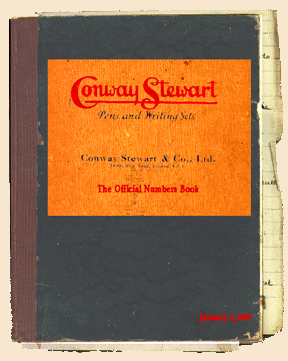 ANY PEOPLE are mystified by the Conway Stewart numbering system. Most Conway Stewarts have a serial number imprinted on the barrel, and the natural question to ask is do these numbers mean anything? Both Watermans and Swan have numbering systems that indicate such things as dimensions, design, color combinations and nib sizes, but the Conway Stewart numbers have (almost) no rhyme or reason. And that seems to be the answer. If one makes a list of all the Conway Stewart numbers known so far, one get a series from No. 1 to No. 1,216. ANY PEOPLE are mystified by the Conway Stewart numbering system. Most Conway Stewarts have a serial number imprinted on the barrel, and the natural question to ask is do these numbers mean anything? Both Watermans and Swan have numbering systems that indicate such things as dimensions, design, color combinations and nib sizes, but the Conway Stewart numbers have (almost) no rhyme or reason. And that seems to be the answer. If one makes a list of all the Conway Stewart numbers known so far, one get a series from No. 1 to No. 1,216. |
 |
The "L" suffix means that its a longer version, or for Dinkies its a ring-top with a silk-lanyard; but what does "P" mean? Then there are numbers such as 3, 9, 33, 34, 38, and many more - did they ever exist and are they waiting to be discovered? (New numbers still frequently turn up.)
 enultimately there are the no-number pens, which fortunately are nearly all named, like "italic" or "shorthand' or "Universal" or "International", and the custom pens for retailers with names such as "The Castle", "The Clubman", The Tudor Pen", "The Barnsley Express" etc. enultimately there are the no-number pens, which fortunately are nearly all named, like "italic" or "shorthand' or "Universal" or "International", and the custom pens for retailers with names such as "The Castle", "The Clubman", The Tudor Pen", "The Barnsley Express" etc.
|
 here is some doubling-up, particularly between the "Safeties", the early "eye-droppers", the early "Duro" series and the later pens, but most of the models have a unique number. So the conclusion is: there must have been a ledger somewhere, probably chucked in the waste-paper basket, or trashed as we now say, when the final curtain came down on the original Conway Stewart saga. If the CEO used this ledger to issue numbers, he did so in some sort of order even though it certainly wasn't chronological. A lot of the higher numbers are early models, and contrary-wise. here is some doubling-up, particularly between the "Safeties", the early "eye-droppers", the early "Duro" series and the later pens, but most of the models have a unique number. So the conclusion is: there must have been a ledger somewhere, probably chucked in the waste-paper basket, or trashed as we now say, when the final curtain came down on the original Conway Stewart saga. If the CEO used this ledger to issue numbers, he did so in some sort of order even though it certainly wasn't chronological. A lot of the higher numbers are early models, and contrary-wise.
|
As if the book was opened blindfold and a pin was used to mark the spot!
Quite clearly certain models received an alternative of two numbers, one for the local market and one for export, for example the 75 for the local market and the 70 for export, or the 479 for local and 480 for export. And then there are also letter qualifications to the numbers. Any number followed by a letter "M" means that its a mottled hard rubber model. A "T" suffix means its a tan or red-hard rubber. Also there are "A", "C" and "S" particularly for the Dinkies and I don't know what they mean though all the "S"s seem to be made in what we now called the "toothpaste" pattern. |
 ltimately, we have the Conway Stewart pencils, which also have a numbering system. The pencils often make up sets with the pens, having identical trimmings and were sold in boxes or pouches which were also numbered, though paradoxically, their numbers don't appear on the boxes. ltimately, we have the Conway Stewart pencils, which also have a numbering system. The pencils often make up sets with the pens, having identical trimmings and were sold in boxes or pouches which were also numbered, though paradoxically, their numbers don't appear on the boxes.
 ell me your number and I'll tell you about your pen! Or better still, just open this original book of numbers found while I was rummaging through the trash-cans in Shoe Lane, London (just kidding). ell me your number and I'll tell you about your pen! Or better still, just open this original book of numbers found while I was rummaging through the trash-cans in Shoe Lane, London (just kidding).
|


